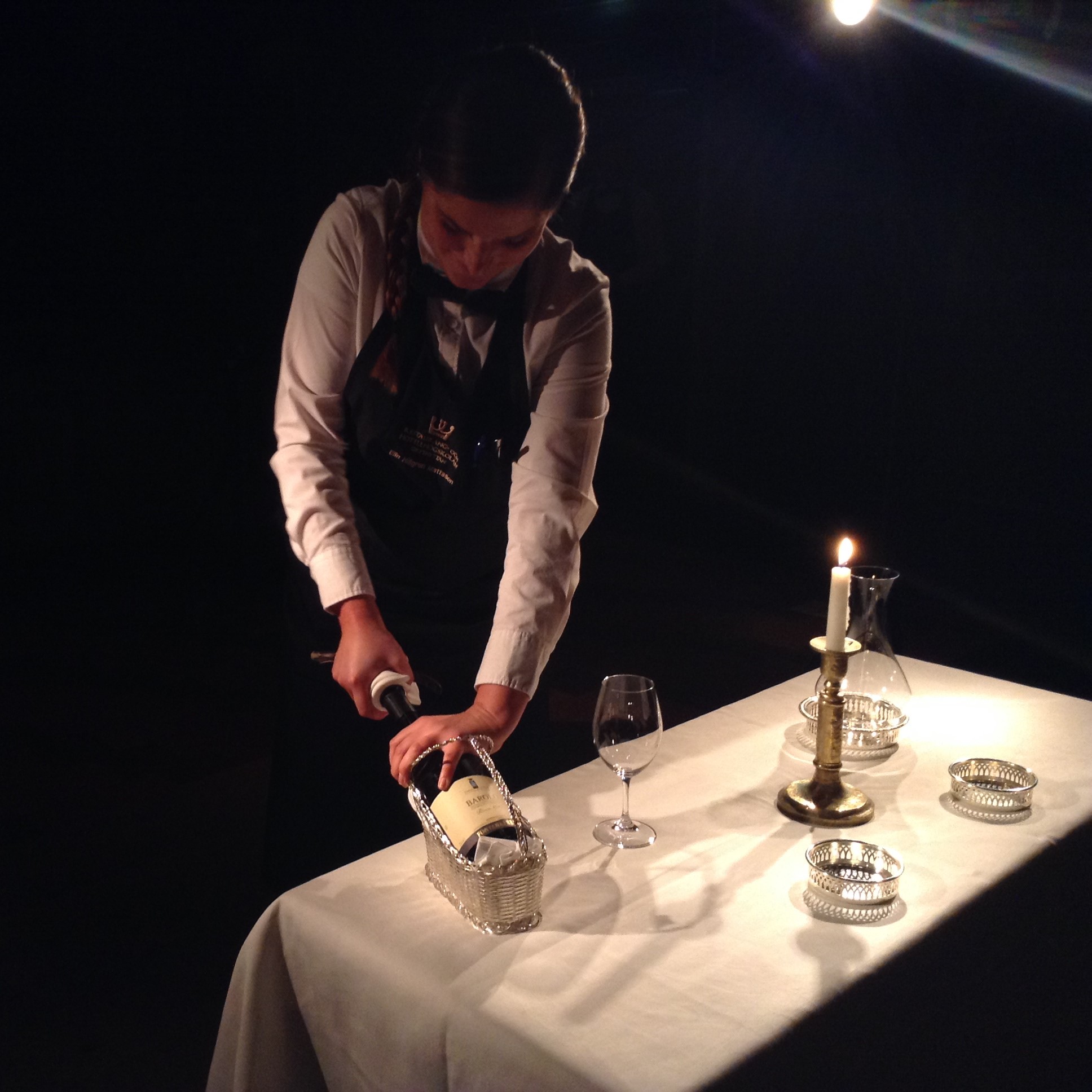Sommelier craft
Aesthetic judgements in the performance of decanting
DOI:
https://doi.org/10.7577/formakademisk.5399Emneord (Nøkkelord):
Culinary Arts and Meal Science, Restaurant, Sommellerie, Beverage, Dining roomSammendrag
This performance study focuses on sommeliers, delving into what constitutes their work and the process of achieving this title. Sommeliers are wine specialists tasked with the responsibility of ensuring that beverages are served properly in combination with food. Similar to other craft persons, the sommelier’s craft is connected to their knowledge of the products, primarily wine and other beverages, and the products’ relation to different foods. The art of tasting is an acquired knowledge, an embodied craft, a central professional competence to determine the quality of beverages. Other elements of sommelier knowledge are communication with guests, a social craft, and how to move in relation to the room, a spatial craft, both of which are based on the influence of different contexts. This study highlights the complexity of aesthetic judgements that sommeliers make through their embodied, social and spatial craft practices while decanting wine and serving it to a guest. It uses a video-reflexive ethnography to emphasise the aesthetics of the sommelier craft. The decanting is carried out in line with the guidelines of the International Sommelier Association. Simultaneously, some judgements in the performance must be articulated verbally to emphasise the complexity of the different crafts in relation to the importance of understanding the complexity in adopting the service to the situation. Social, embodied and spatial craft practices, in relation to the sommelier, show how aesthetic judgements are developed into a willingness to understand people and satisfy guests. This is achieved by 'cognitive planning’, which entails working diligently and preparing to enhance the efficiency of the craft, and by ‘situational adjustments’ that occur in real time to improve and optimise the guest's experience.
Referanser
Ajjawi, R., Hilder, J., Noble, C., Teodorczuk, A., & Billett, S. (2020). Using video‐reflexive ethnography to understand complexity and change practice. Medical Education,54(10), 908–914. https://doi.org/10.1111/medu.14156
Ben Dewald, B. W. A. (2008). The role of the sommeliers and their influence on US restaurant wine sales. International Journal of Wine Business Research,20(2), 111–123. https://doi.org/10.1108/17511060810883740
Bourdieu, P. (1979/1984). Distinction : Asocial critique of the judgement of taste. Harvard University Press.
Bourdieu, P. (1990). The logic of practice. Polity Press. https://doi.org/10.1515/9781503621749
Fereday, J., & Muir-Cochrane, E. (2006). Demonstrating rigor using thematic analysis: A hybrid approach of inductive and deductive coding and theme development. International Journal of Qualitative Methods,5(1), 80–92. https://doi.org/10.1177/160940690600500107
Graneheim, U. H., & Lundman, B. (2004). Qualitative content analysis in nursing research: Concepts, procedures and measures to achieve trustworthiness. Nurse Education Today, 24(2),105–112. https://doi.org/10.1016/j.nedt.2003.10.001
Herdenstam, A. S., H. (2023). Sommelierens estetiska hantverk –Vinprovning som aristotelisk kunskap i handling. In K. Thurfjell (Ed.), Gastronomisk Kalender 2024 (In press). Carlssons bokförlag, Stockholm.
Lee, K.-S., & Ruck, K. J. (2022). Barista diary: An autoethnography studying the operational experience of third-wave coffee shop baristas. International Journal of Hospitality Management,102.https://doi.org/10.1016/j.ijhm.2022.103182
Manske, M., & Cordua, G. (2005). Understanding the sommelier effect. International Journal of Contemporary Hospitality Management,17(7), 569–576. https://doi.org/10.1108/09596110510620645
Muñoz, F., Hildebrandt, A., Schacht, A., Stürmer, B., Bröcker, F., Martín-Loeches, M., & Sommer, W. (2018). What makes the hedonic experience of a meal in a top restaurant special and retrievable in the long term? Meal-related, social and personality factors. Appetite,125, 454–465. https://doi.org/10.1016/j.appet.2018.02.024
Ocejo, R. E. (2012). At your service: The meanings and practices of contemporary bartenders. European Journal of Cultural Studies,15(5), 642–658. https://doi.org/10.1177/1367549412445761
Olive, R. (2019). Thinking the social through myself: Reflexivity in research practice. In Research Methods in Outdoor Studies(pp. 121–129). Routledge.
Reckwitz, A. (2002). Toward a theory of social practices: A development in culturalist theorizing. European Journal of Social Theory,5(2), 243–263. https://doi.org/10.1177/13684310222225432
Robinson, J. (2006). The Oxford companion to wine. Oxford University Press. https://doi.org/10.1093/acref/9780198609902.001.0001
Scander, H. (2019). Food and beverage combinations : Sommeliers' perspectives and consumer patterns in Sweden(Publication Number 14) [Doctoral thesis, comprehensive summary, Örebro University]. DiVA. Örebro. http://urn.kb.se/resolve?urn=urn:nbn:se:oru:diva-74611
Scander, H., & Jakobsson, B. M. (2022). Gastronomy competition and restaurant practice: Sommeliers’ understanding of the game of social craft. International Journal of Gastronomy and Food Science, 29, 100567.https://doi.org/10.1016/j.ijgfs.2022.100567
Scander, H., Neuman, N., & Tellström, R. (2019). Sommeliers' food and beverage combinations: Social conventions and professional identity. Journal of Gastronomy and Tourism,4(1), 29–39.
Scander, H., Neuman, N., Tellström, R., & Yngve, A. (2020). Acquiring competence: Sommeliers on “good combinations” of food and beverages. International Journal of Gastronomy and Food Science,20. https://doi.org/https://doi.org/10.1016/j.ijgfs.2020.100199
Schatzki, T. R. (1996). Social practices: A Wittgensteinian approach to human activity and the social. Cambridge University Press. Henrik SCANDER – Sommelier craft
Smith Maguire, J. (2010). Provenance and the liminality of production and consumption: The case of wine promoters. Marketing Theory,10(3), 269-282. https://doi.org/10.1177/1470593110373190
Wilson, E. R. (2019). Managing portfolio lives: Flexibility and privilege amongst upscale restaurant workers in Los Angeles. Qualitative Sociology,42(3), 321–336. https://doi.org/10.1007/s11133-019-09420-4.

Nedlastinger
Publisert
Hvordan referere
Utgave
Seksjon
Lisens
Opphavsrett 2023 Henrik Scander

Dette verket er lisensiert under Creative Commons Attribution-NoDerivatives 4.0 International License.
- Forfatteren(e) beholder sin opphavs- og kopieringsrett til eget manuskript, men gir tidsskriftet varig rett til 1) å fremføre manuskriptet for offentligheten i den opprinnelig publiserte digitale form, og 2) å registreres og siteres som første publisering av manuskriptet.
- Forfatteren må selv forvalte sine økonomiske kopieringsrettigheter overfor eventuell tredjepart.
- Tidsskriftet gir ingen økonomisk eller annen kompensasjon for innsendte bidrag, medmindre det er gjort særskilt avtale om dette med forfatteren(e).
- Tidsskriftet plikter å arkivere manuskriptet (inklusive metadata) i den opprinnelig publiserte digitale form, i minst ett dertil egnet åpent tilgjengelig langtidsarkiv for digitalt materiell, som for eksempel i de norske universitetenes institusjonsarkiv innen rammen av NORA-samarbeidet.
Verket vil bli publisert OpenAccess med en Creative Commons 4.0-lisens som tillater alle å lese, dele og tilpasse innholdet, også kommersielt, under lisensvilkårene:
Dette verket må tilskrives/ krediteres på riktig måte, en lenke må gis til CC-BY 4.0-lisensen, og endringer som er gjort må angis på en rimelig måte, men ikke på noen måte som antyder at lisensgiveren støtter deg eller din bruk.



